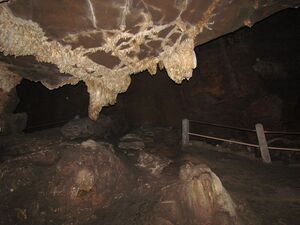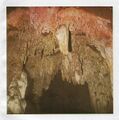Kutumsar
| Author:Laxman Burdak IFS (R) |


Kutumsar (कुटुमसर) is town in Jagdalpur tahsil in Bastar district in Chhatisgarh. It is known for Kutumsar Caves. Author (Laxman Burdak) visited it on 21.12.1982. Kotumsar cave is a major attraction for people interested in ecotourism.
Variants
- Kotumsar
- Kotamsar
- Kotumsar Cave
- Kutumsar Cave
- Gopansar cave (Gopan = hidden)
- Gopansar (गोपनसर) (छिपी हुई गुफा)
Location


Kutumsar is a small Village in Darbha Tehsil in Bastar District of Chattisgarh State, India. It comes under Kutumsar Panchayath. It is located 39 KM towards South from District head quarters Jagdalpur.[1]
Kotumsar Caves are situated at a distance of about 40 km from Jagdalpur. It is a limestone cave formed on the Kanger limestone belt, situated near the bank of the River Kanger, a tributary of the Kolab River. The entrance coordinates are 18052’09”N; 81056’05” E (WGS 84) and it lies at an altitude of 560 m above sea level. A vertical fissure in the wall of a hill serves as the main entry for the cave, and from there for the convenience of tourists a concrete path has been made extending to the end of the cave. The main tunnel of the cave is nearly 200 m long with several lateral and downward passages. Various types of offer panoramic views.[2]
Jat Gotras Namesake
Kutumsar Caves
Kutumsar Cave: Kotumsar cave is a limestone cave located near Jagdalpur in the Indian state of Chhattisgarh. Kotumsar cave is a major attraction for people interested in ecotourism. It was initially named Gopansar cave (Gopan = hidden) but the present name Kotumsar became more popular as the cave is located near a village named ‘Kotumsar’. Kotumsar cave formed on the Kanger limestone belt, situated near the bank of the River Kanger, a tributary of the Kolab River.
Kotumsar Caves are about 35 meters below ground level and around 1371 meters long. There are stairs at the entrance and once inside, you can see stalactite formations. No sunlight reaches the cave and in little puddles of water there live blind fish and frogs. The cave has many connecting compartments. At the end of the cave is a stalagmite Shiva-linga, which is revered by tribals and visitors alike.
Kotumsar Cave is a subterranean limestone cave located near the banks of Kanger River in the western portion of the national park. It was discovered by the local people around year 1900 and explored by a renowned geographer Shri Sankar Tiwari in 1951 and it is one of the best known caves in Chhattisgarh as well as in India.
The floor of the cave consists of soil/clay, pebbles, rocks and water pools with several lateral and downward passages. Perpetual darkness and constant temperature (28 °C + 1 °C) prevails inside the cave. For entry into the cave, cement concrete steps, Steel steps and railings are available near the entrance side.
These caves have got the distinction of being India's first most biologically explored cave. As they are underground, there is pitch-darkness inside. It features stalactite and stalagmite formations. Entry to the caves is through the narrow stairs and visitors have to pass through tall, narrow chambers for gaining access to the main hall that features superb acoustics. The caves feature five chambers having several blind wells. Many tribal tales are also associated with it and are also known as Gupanpal or Kutamsar Caves. The stalactites found inside the cave have been an interesting research topic for scientists and even arouse the curiosity among the visitors.
Kotumsar Cave harbours a variety of fauna like bats, frogs, snakes, crickets, spiders, fishes, millipedes, etc. Fishes and frogs are found in the ditches of the cave where as bats, spiders, crickets are found on the ceilings and walls of the cave. Dr. Jayant Biswas has well documented the biology of the cave organisms living in Kotumsar Cave
There is lack of oxygen when going deep into the caves. In view of which, for safety reasons, entry beyond certain points has been restricted.
The cave is closed from 15 June to 31 October during rainy season. The cave needs removal of debris before tourist season.[3]
History
The cave has been known since the British era of India, but it was not taken seriously until the 1950s when the geography professor Dr. Shankar Tiwari visited the cave and attempted to explore its chambers with limited resources and equipment. The cave was first systematically mapped in the 1980s by Dr. Jayant Biswas (then a Ph.D. scholar), guided by a Romanian caver. The map was first published in Biswas's Ph.D. dissertation in 1990, and in 1992 by him in the internationally recognized publication of the National Speleological Society [4].
कुटुमसर गुफा
कुटुमसर गुफा छत्तीसगढ़ के बस्तर जिले में कांगेर घाटी राष्ट्रीय उद्यान में स्थित है. लेखक (लक्ष्मण बुरड़क) द्बवारा बस्तर जिले में मध्य बस्तर वन मंडल जगदलपुर में दरभा रेंज में प्रशिक्षण अवधी (16.07.1982-30.04.1983) के दौरान यहाँ अनेक बार जाना हुआ. यह गुफा दरभा रेंज में ही दरभा से कुछ किमी दूरी पर ही स्थित है.
यह भारत की सबसे गहरी गुफा मानी जाती है जो 60 - 200 फिट गहरी है तथा इसकी लम्बाई 4500 फिट है. इस गुफा की तुलना विश्व की सबसे लम्बी गुफा ' कर्ल्सवार ऑफ़ केव ' (अमेरिका ) से की जाती है. इस गुफा की खोज 1950 के दशक में भूगोल के प्रोफेसर डॉ. शंकर तिवारी ने कुछ स्थानीय आदिवासियों की मदद से की थी. इस गुफा को पहले गोपनसर (छिपी हुई गुफा) कहते थे जो बाद में कुटुमसर गाँव के नजदीक होने से कुटुमसर गुफा के नाम से प्रसिद्द हुई.
गूपनसर या कुटुमसर की गुफाएं धरातल से 60-200 फुट की गहराई में अंधेरी दुनिया का एक सम्मोहक स्थल है. पाताललोकीय इस अद्भुत सौंदर्य स्थल में प्रकृति जन्य स्टेलेक्टाइट (Stalactite) एवं स्टेलेग्माइट (Stalagmite) के अलौकिक झाड़-फानूस हैं. चूने का पानी जब गुफा की छत से टपकता है तो छत पर बनने वाली चूने की संरचना को स्टेलेक्टाइट (Stalactite) कहते है. चुने का पानी जब गुफा के फर्स पर गिरता है तो चूने के ज़मने से जो संरचना बनती है उसको स्टेलेग्माइट (Stalagmite) कहते हैं. यह भारत की प्रथम भूगर्भित गुफा है जहां एक भारतीय अन्वेषक द्वारा कन्द्राशास्त्रीय कार्य किया गया है. यहां प्रथम बार देश की सफेद अंधी मछलियां, गुफा के मोती तथा पत्थरों का संगीत कक्षा खोजा गया है. यह अन्वेषक प्रोफेसर शंकर तिवारी द्वारा खोजा गया तथा उनके नाम पर "केम्पीओला शंकराई" के नाम से जाना जाने वाला गुफाई झींगुर प्राणी शास्त्र की दुनिया के लिए एक नई जाति है. इस गुफा में रंग-बिरंगी अंधी मछलिया पाई जाती है जिन्हे प्रोफेसर शंकर तिवारी के नाम पर "कप्पीओला शंकराई" कहते हैं.
External links
Gallery
References
- ↑ https://www.onefivenine.com/india/villages/Bastar/Darbha/Kutumsar
- ↑ https://bastar.gov.in/en/gallery/kotumsar-cave/
- ↑ "Jagdalpur Travel Guide - Kotumsar and Kailash Caves - Kanger Valley National Park". Indiantravelguide.com.
- ↑ Jayant Biswas, Kotumsar cave ecosystem:An interaction between geophysical, chemical, and biological characteristics, January 1992
Back to Chhattisgarh



